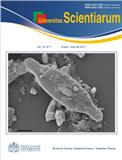Abstract
Objective: To make computational predictions of the structure of the human proteins Hsp27, αB-crystalline and HspB8. Materials and methods. The prediction of the secondary structure was obtained by a consensus of the programs for secondary prediction GOR 4, nnPred, Sspro, APSSP2, JPredict, Porter, Prof, SOPMA, HNN and Psi-Pred. The models of tertiary structure were built from fragments homologous to proteins with tertiary known structure that were obtained by multiple alignments. Using the primary sequence we obtained the antigenicity profiles of native proteins and we analyzed the profiles of hydrophobicity, polarity, flexibility and accessibility of both native and mutant proteins. Results. Predictions of the secondary and tertiary structures of the studied proteins show that in the three cases, more than 65% are coil regions, 20-25 % are folded sheet and less than 10% are alpha helix. Analyses of the primary structure show that at least one of the studied profiles in every mutation is altered. Conclusions. The comparative analyses of structure suggest that mutations affect the solubility of the mutated proteins and hence affect their function as molecular chaperones
Key words: Hsp27, αB-cristalline, HspB8, prediction of secondary structure, computational model of tertiary structure
Univ. Sci. is registered under a Creative Commons Attribution 4.0 International Public License. Thus, this work may be reproduced, distributed, and publicly shared in digital format, as long as the names of the authors and Pontificia Universidad Javeriana are acknowledged. Others are allowed to quote, adapt, transform, auto-archive, republish, and create based on this material, for any purpose (even commercial ones), provided the authorship is duly acknowledged, a link to the original work is provided, and it is specified if changes have been made. Pontificia Universidad Javeriana does not hold the rights of published works and the authors are solely responsible for the contents of their works; they keep the moral, intellectual, privacy, and publicity rights. Approving the intervention of the work (review, copy-editing, translation, layout) and the following outreach, are granted through an use license and not through an assignment of rights. This means the journal and Pontificia Universidad Javeriana cannot be held responsible for any ethical malpractice by the authors. As a consequence of the protection granted by the use license, the journal is not required to publish recantations or modify information already published, unless the errata stems from the editorial management process. Publishing contents in this journal does not generate royalties for contributors.



